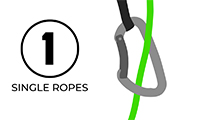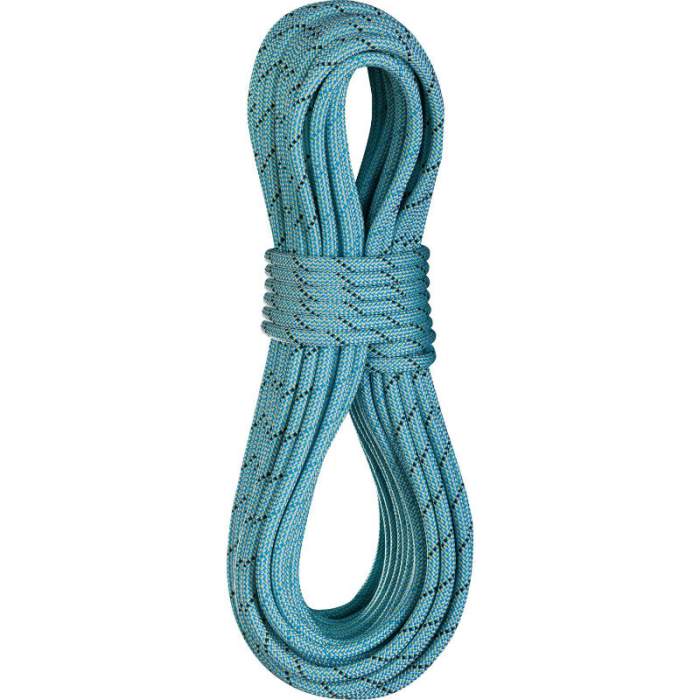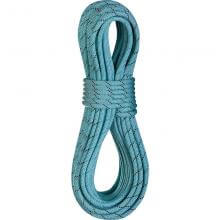9.7mm Anniversary 70m 2xDry
Description
Pro Shield finish for optimal performance
Dry Shield finish for outstanding dirt and water resistance
Thermo Shield treatment for perfect handling
With limited edition Caddy rope bag
Retail price
When you click a link below and then checkout online, no matter what you buy (climbing gear or not), we get a small commission that helps us keep this site up-to-date. Thanks!
| Weight | 61.0 g/m 9.413 lbs / 4270 g |
| Diameter (millimeters) | 9.7 mm |
| Length (meters) | 70 m |
Rope Type  Type
There are 3 types of dynamic ropes that are used by climbers. They are known as Single, Half (Double), and Twin. The type of rope preferred varies by climbing style, location, and region. Single
By far, the most common type of rope. Great for indoors and out. In the US, it is the most common sport and big wall and are also used for trad cragging. The handling is simple and the diameter options are quite varied. Half (Double)
The best cure for a meandering route, only one of the ropes will clip into each piece of protection so a mindful climber can can reduce rope drag considerably. You can also rappel twice the distance, it’s easier to safely protect traverse pitches and there is a smaller chance that both ropes would become damaged (by rockfall, crampons, etc). Twin
Both ropes must be clipped through each piece of protection. This is the lightest style of (two) ropes. They excel for rappels, going twice the distance vs a single rope, but do not have the ability to mitigate rope drag even though there are two ropes. It is unlikely both ropes will be damaged at once, and is why many alpine, ice and mixed climbers choose twin and/or half ropes. Learn More
Every rope type and when to use them | Single |
UIAA Falls (Single / Half / Twin)  UIAA FallsThis refers to the number of UIAA falls a rope has been tested to be able to withstand without breaking. The UIAA fall is a complicated test that is designed to create a uniform standard for strength in ropes, and is not generally reflective of real-world climbing situations. The test involves dropping a weight tied to the rope in such a way that it will see the highest amount of force a real-world situation could generate. The UIAA requires that Single and Half ropes must pass this test without breaking at least 5 times, while twin ropes must withstand 12 falls. In practice, it can likely be concluded that ropes that have higher than this standard number of falls will be stronger and put up with more abuse. It is important to note that any rope that is UIAA or EN certified is considered safe to climb on, regardless of the number of UIAA falls it is rated for. | 9 falls / - / - |
Dynamic Elongation (Single / Half / Twin)  Dynamic ElongationThis refers to the amount of stretch measured during the dynamic testing (or drop test) used when certifying ropes. Higher stretch will absorb more force and result in a softer catch but increases chances of groundfall at the beginning of a climb. The EN and UIAA require a stretch of at least 10% and no more than 40% for dynamic ropes. Single and Half ropes are tested individually and Twin ropes are tested as a pair. | 31.0 % / - / - |
Static Elongation (Single / Half / Twin)  Static ElongationThis refers to the amount of stretch measured during the static test used when certifying ropes. Most climbers will notice the difference in static elongation when climbing in a top rope situation, where higher stretch will make for a springier belay and could result in a ground fall when climbing closer to the ground. The EN and UIAA require a stretch of no more than 10% for Single and Twin ropes and no more than 12% for Half ropes. Single and Half ropes are tested individually and Twin ropes are tested as a pair. | 9.2 % / - / - |
Impact Force (Single / Half / Twin)  Impact ForceImpact force is the amount of force in kN that is measured at the testing mass during the UIAA dynamic drop rope test. When the weight is dropped, the force measured must be at or below 12kN for Single and Twin ropes and 8kN for Half ropes. The real world application of this test is determining that the rope can dissipate and absorb the appropriate amount of force from the fall as it would be felt by the climber. The variables used in the test set a situation that is well beyond anything climbers encounter, and shouldn't be considered realistic to actual climbing situations. In reality forces of this magnitude would result in severe injury as this test is designed to test the limits of the rope and not the comfort of the climber. | 8.70 kN / - / - |
Dry Treatment  Dry TreatmentWhen a rope is dry treated, it has had a coating applied to its core fibers, its sheath fibers, or both. The purpose of this coating is to reduce the amount of water the rope can absorb when in wet or icy conditions. Wet ropes are heavier, handle and belay differently, and have been tested to be weaker than dry ropes. Many climbers prefer dry treated ropes for very dusty or dirty environments, as they are more resistant to uptake of dirt and can stay cleaner longer. Learn More
Benefits of Dry vs Non-Dry ropes | Sheath & Core |
| Sheath Proportion (%) | 41.0 % |
| Sheath Slippage (mm) | 0 mm |
| Type of Middle Mark | Marking |
| Rope End Marker | None |
| Certification | CE, EN, UIAA |
RFID / NFC Option  RFID and NCFThis technology can be helpful if you are a gym or professional business where you'd like to track the usage and age of your ropes. RFID is how items are uniquely identified using radio waves (Radio Frequency Identification). It's for 1-way communication from 10cm to 100m away depending on the frequency. Example: Airport Baggage. NFC is a subset of RFID that is restrained to close proximity communication typically less than 10cm (Near Field Communication). NFC chips can operate a 2-way signal to exchange information. Example: Apple Pay. | None |
No reviews yet.
The first thing I noticed about the Anniversary Rope – as I spent half an hour untangling it – is that it has a really nice ‘hand’, that term climbers use for the feel of a rope. This initial feeling proved to be accurate. Many ropes, particularly the first couple of times you use them, can often get annoyingly kinky, but the Anniversary Rope has run smoothly from the beginning, only really giving me problems when I have lowered climbers off badly set up anchors (like the clip-and-goes on Redex Irlont Sudano at Werribee Gorge) and that is hardly the fault of the rope. It also hasn’t stiffened up with use as some ropes tend to do.
I've been using this rope for about a month and have put it through an inordinate amount of abuse during that time. In addition to the standard wear received from sport and trad climbing, and the standard lead falls associated, I've also been jugging on it and rapping over plenty of edges to see if the sheath can take a beating. So far, I'm giving this rope an A rating, surprisingly for the fact that it's completely average.
The major drawback of the Anniversary Rope is the fact that it only comes in 60-meter lengths. Although many climbs don’t demand anything longer, the trend in some areas is toward extensions and longer pitches of 35 and even 40 meters. If you climb in these areas, then this won’t be the rope for you. If, however, 30 meters is the extent of your particular klettergarten’s climbs then it would be a stretch to do better than the Anniversary.


